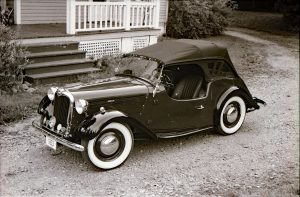History/driving impressions originally published in AutoWeek April 27, 1987
I never quite understood why Julius Caesar wanted to conquer the British Isles. It never seemed quite worth the effort, especially when home was sunny Italy and offered all the vino you could tote to the Forum. It also never made much sense to me that a country most famous for fog should also be known for its open automobiles. After all, riding around with the rain in your teeth is more fun to talk about than to do.
Nevertheless, here we have the British Isles, where summer is good only if it comes on a weekend when you can enjoy it, renowned for roadsters. To be fair, the country produced a variety of sedans – which for reasons understood only to the British they named after drinking establishments of the American Old West – but these, these saloons, were, for the most part, frumpy and looked as if their girdles were too tight.
So naturally follows that when MG finally decided to enter the middle of the 20th century with the MGA, it should be with a roadster. It was much more aerodynamic than the T series which preceded it, but still there was that cloth top and flimsy side curtains and doors that didn’t even have handles on the outside.
Anyway, the MGA was the savior of MG, coming along in 1955 just in time to save the firm from the TF, which was old-fashioned as the TD and TC but with hardly as much style. With the advent of the MGA the company sold more cars than it ever had before.
For rallying, however, drivers and navigator had other things to worry about than a flapping fabric top, and certainly no one wanted to do the Monte with the top down. So MG invented the detachable hardtop, a removable solid lid that not only made foul weather less obnoxious but also added a few miles per hour to the top speed.
The next logical step was making the hardtop non-removable. But not for the sake of competition. The new steel-roofed coupe was to be something of a junior GT, the thing for someone who lusted after an XK-120 coupe but came up a few pounds (Sterling) short. The lines were almost identical to the hardtop, though the windscreen gained a little in height and curve.
Civilization really appeared, however, in the side windows that actually went up and down when you turned a crank on the door. There were little vent windows and door locks and even handles on the outside, though these were little vertical levers at the top edge of the door. MG also upgraded the interior.
The coupe’s debut was at the 1956 London auto show. The addition of the permanent roof meant an increase of some 160lbs, but as Abington had found four more horses in the 1500 MGA – for a total of 72bhp – acceleration was marginally improved. Zero to sixty took 14.2sec and the quarter-mile 19.2sec. Perhaps the most significant – at least from a philosophical standpoint – was that the improved aerodynamics of the steel roof made the coupe the first true 100 mile-per-hour production MG. All this for list price of $2,750.
Only about 15 percent of the 101,081 MGA’s built were coupes. The fixed roof model was, however, produced for virtually this entire 1956 to 1962 production run and with all the major engine variants, even including the Twin Cam.
Pat and Richard Newman of Laurel, Maryland, own a 1500 (actually 1489cc) coupe, one of the early smaller-engined cars. Entry is not easy: One is required to do an accordion impression as the doors are short and not very tall. Once inside, it is – take your choice – either a) snug, or b) claustrophobic. The driver is at close quarters with the passenger and just about everything else; the dashboard is fingertips away from the steering wheel. The normally tight quarters of the MGA are only emphasized by the steel roof.
The MGA was an improvement over the TF by virtue of dropping the seating between the frame rails rather than over them. That also placed the occupants closer to the toasty mechanicals. Considering that ventilation is limited to two smaller side windows and the heater, the interior of the coupe is not the place to spend a summer vacation.
But everything being close means nothing is out of reach, and the MGA communicates its 1950s’ performance parameters complete and unabridged. The shifter is notchy but precise and the steering wheel transmits a message from every square inch of the tire contact patch, few though those inches be. The engine is pukka from its SU carbs to its rorty exhaust, and it knows the importance of being earnest.
If the coupe fell short of four season grand touring, it compensated in competition. The coupe garnered numerous class wins in international rallying and reached its high point in circuit racing at Sebring in 1961 with a first and second in class.
The MGA coupe is surely the product of another time. It’s easily outperformed by any number of modern econo-sedans and it can’t even justify its existence with a fold down roof. It is easy to question the wisdom of producing a sports car with a roof, forgetting, conveniently, that the majority of current sports models are not convertibles. Which, of course, makes perfect sense when you have to drive it every day.
And for the MGA, which was once everyman’s everyday sports car, the coupe was equally logical. Especially since it came from England.













What Do You Think?
You must be logged in to post a comment.